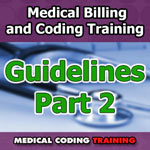In Part 1 of Medical Billing and Coding Training Basic Surgery Guidelines, I focused on insurance coverage, payer rules, and modifier usage. This section will focus on what I zero in on when looking over a surgical operative note.
First of all, I want to be certain the documentation covers all pertinent areas so I approach each note as if I was auditing a patient chart. For the record, this approach can also be used for auditing surgical procedures already coded by another professional.
I begin by verifying the patient name, date of birth, and insurance. Always match the date of surgery on the surgeon’s notes with the hospital medical record. Believe it or not, I run across discrepancies with dates of surgery often. You also want to double check the location of the surgery. Sometimes a procedure will be performed in an outpatient setting and other times at an inpatient location. Hospital pre-registration will indicate the location and if your location does not match the pre-registration, the surgeon’s claim will deny; so date of surgery and location are very important.
Review the operation(s) or procedure(s) performed.
Medical Billing and Coding Training — Using Checklist
Have a check list to work from so you do not miss important information. Below is a list I use as a guide:
• Was the pre-operative and post-operative diagnosis indicated?
• Was the technical procedure described?
• Were there biopsies or specimens removed?
• Was there a description of the findings?
• Were there co-surgeons?
• Was the patient’s condition stated post-operatively?
• Were any operative complications described?
• Was a complaint mentioned?
• Were there any operative scopes used?
• Were specific terms describing the surgery used such as “difficult” or “complicated”?
• Was there general anesthesia or conscious sedation involved?
• Were there extenuating circumstances prolonging the operation?
• How many surgeries were performed during the surgical session?
• Are any of the surgeries bundled into one another, such as the surgical approach and actual surgery?
• How thorough was the operative report in terms of sequencing events and details?
• Are modifiers required?
• Was a history noted?
• Were vitals, an exam, or laboratory tests ordered?
• Were there any added remarks or recommendations regarding the patient or the surgery?
• Was there a decision for immediate surgery indicated (modifier 57 for invasive and 25 for
non-invasive)?
• Does the surgery fall under zero (0) global days such as a non-invasive colonoscopy or a 90 day global package?
• Was this a return to the operating room due to complications from a previous surgery during the post-op?
If you find your CPC credential has offered an opportunity to audit previously coded surgical procedures, you can add these additional queries:
• Is there any evidence of “unbundling?”
• What CPT codes were billed?
• Does the documentation validate the CPT codes used?
• Are there any additional codes or modifiers that should have been billed? If so, which codes?
As you grow more proficient in coding, you will fine-tune these questions based on the particular specialty you are coding. I hope this list helps you successfully begin your surgical coding journey!
Related Posts:
- Medical Terminology & Anatomy Medical Coding
- Medical Billing and Coding Training- General Surgery Guidelines – Part 1
- Medical Coding Training

![[CCO] Certification Coaching Organization LLC [CCO] Certification Coaching Organization LLC](https://www.cco.us/wp-content/uploads/2015/05/CCO-Logo-2015-d3-500px.png)